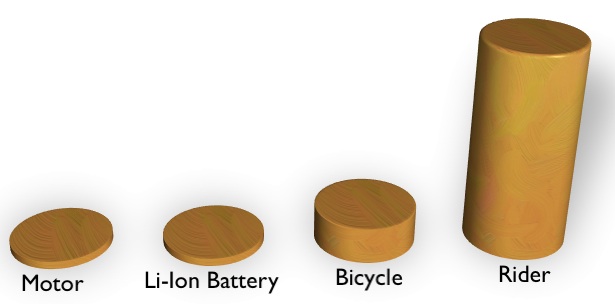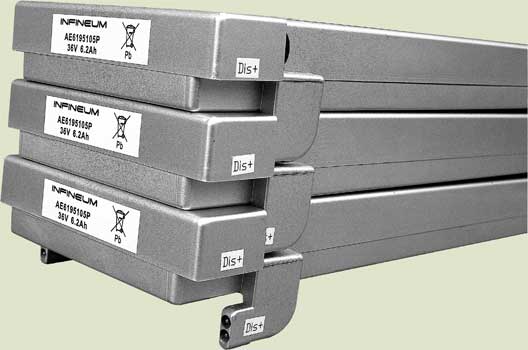Site Map FAQ Link Contact About
Electric Bicycle Weight
One exercise that many people think is always beneficial is getting a bigger motor. But getting a bigger motor means a heavier electric bicycle. Moreover, a more powerful motor requires a bigger battery to achieve the same distance as before and a bigger battery add even more weight.
You probably want to be able to use the pedals and not just have them for decoration. If your electric bicycle is too heavy, pedaling can becomes a pretty hard task.
You can end up adding a considerable amount of weight just to find out that you didn't get what you want. You end up with a heavier, clumsier and much more expensive e-bike.
The right balance

The heavier electric bicycle is more and more resembles an electric scooter and you loss from both ends. You get a lousy e-bike and also a pretty lousy scooter. It becomes too heavy, it gobbles too much energy and it is not suitable for pedaling.
Therefore, it's important to find the right balance between the different parts in order to achieve the optimum performance. Change a little, get a feedback, and act based on this feedback.
On the one hand, you always have to remember that although a big battery will take you further, it's juice is going to end eventually and when it does, you will have to pedal and carry all the extra weight. You have to make sure that you enjoy (and can) riding the e-bike even when the battery is dead and even up-hills!
On the other hand, the effect of weight is largely exaggerated when we are talking about an additional 1-5 kg. People spend thousands to shave off less then 1 kg for a really high-end bike, but it's not always justified (especially in the case of electric bicycles). The additional weight of the electric components is more often then not more than made up for in the e-bike hauling capacity.
But, while a few kilograms are really not such a big deal, adding more then that is where you enter the gray zone which I've just talked about.
Here is a typical scenario:
Common weights:
Weight of a lightweight bicycle ~ 10 kg
Extra weight to support stronger components, bigger tires, etc ~ 4 kg
Motor weight ~ 3 kg
SLA Battery weight ~ 20 kg
or
Lithium Battery weight ~ 3 kg
Assuming:
Rider ~ 80 kg
We get:
Bike with a SLA battery ~ 37 kg or about 50% of the rider weight.
or
Bike with a lithium battery ~ 20 kg or about 25% of the rider weight.
You can see that there is quite a big difference between the weight of different kind of batteries. This is an extreme example, most of differences won't be such large as this one.

Rider Weight
The rider weight is somewhere around 2-8 times the electric bicycle weight (unlike cars or motorcycles where the rider weight play only a marginal part of the overall weight). Therefore, the rider weight itself makes most of the difference in most cases.
The advertised ranges and speed of e-bikes are based on a specific rider weight so you have to be careful here.
Folding Bikes
If you have a folding bicycle that you use regularly with public transport or you carry it upstairs a lot, every gram is important. And in the case of the electronic components, we are talking about lots of grams.
There is a compromise between how much weight you can add and how much weight you can lift. Do try to carry the e-bike with you to get a feeling whether you can handle the weight comfortably or not.
Battery Stacking
There are e-bike models which offer the possibility to carry more then one battery. In such a case, usually each battery is smaller and you can take just one for short errands. Infineum offer electric bicycles with a stacking battery mechanism. You can add a couple of batteries in series on top of each other.

Balance and Comfort
When talking about steering, balance and comfort, two rules are important:
1. You have to keep the center of gravity low. Meaning, you can't just put the battery and the motor in any place, you have to think about where the center of gravity goes. The perfect place for it is somewhere just below the rider.
2. Do not put too much weight on the wheel, especially on the front wheel. The heavier the wheel, the more it moves away from the ground when hitting an obstacle. Then, the rider have to wait until the wheel will hit the ground to gain control again. Therefore, we would want the wheels to be as light as possible.
Weight, Range, Speed and Price
Before moving ahead, you need to decide what the maximum range required from the electric assistance. Use any map program (like Google Maps) to calculate the distance if you are not sure.
Now, you can play with the battery type and capacity and the calculator page and start digging into the numbers.
Rule Of Thumbs
- You really should not be go over overall weight of 25 to 30 kg. Preferably aim as close as possible for the the 20 kg range.
- Try to keep the weight of the wheels to a minimum, this will improve balance and control.
- If you have to carry your bike around a lot, be sure to stay in the 20 kg range! Carrying around more then that is a good work-out but it will just get really annoying after a while.
- Some countries have set a weight limit on electric bicycles. Be sure not to go above this limit if you build your own e-bike.
|









New! Comments
Have your say about what you just read! Leave me a comment in the box below.